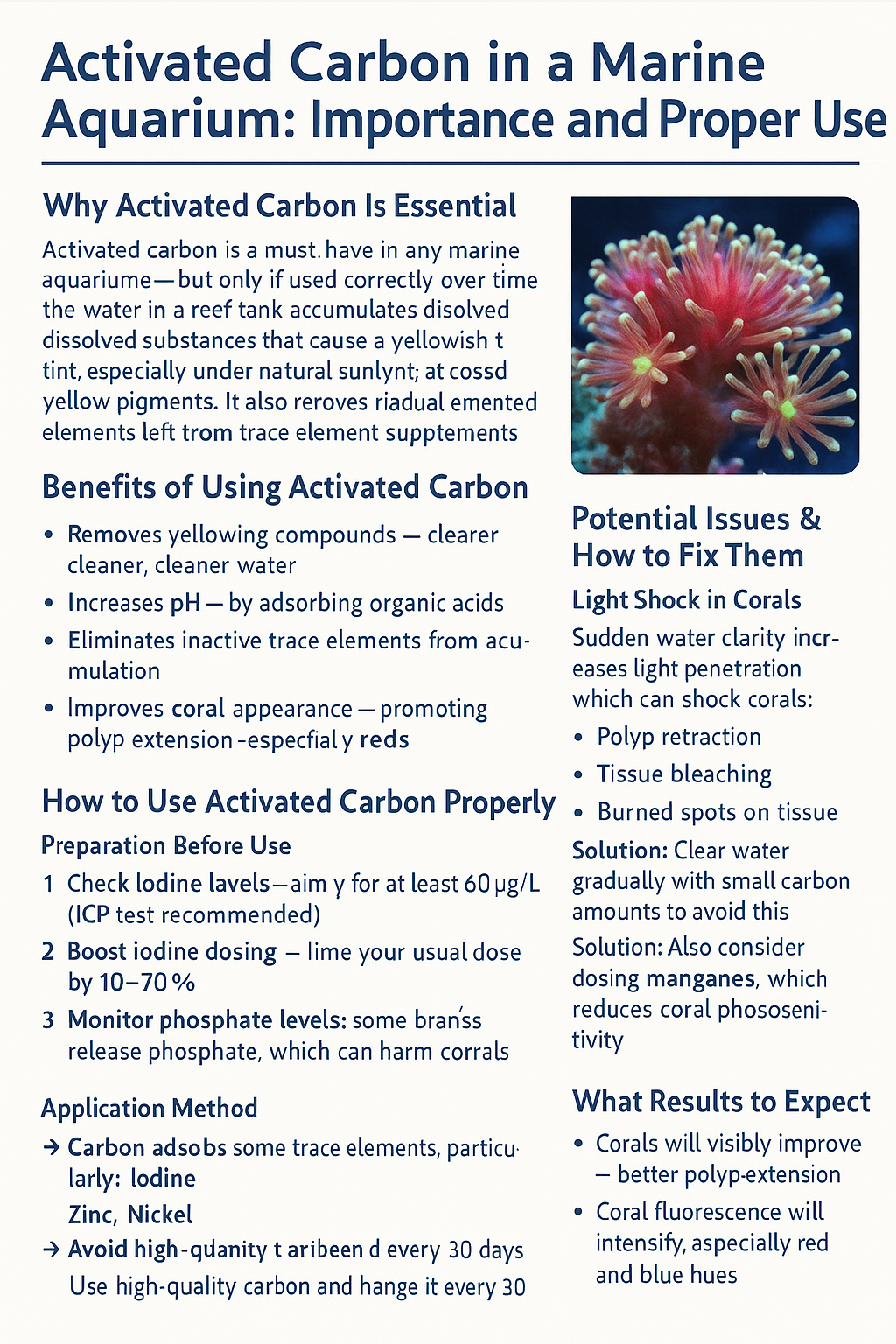
Water Adsorption (Activated Carbon)
Activated Carbon in a Marine Aquarium: Importance and Proper Use
Why Activated Carbon Is Essential
Activated carbon is a must-have in any marine aquarium — but only if used correctly. Over time, the water in a reef tank accumulates dissolved substances that cause a yellowish tint. You can easily spot this when comparing fresh saltwater to tank water — the latter will often appear yellow or even brownish, especially under natural sunlight.
These compounds act as oxidizers and can lower your pH. If you're struggling with persistently low pH, activated carbon can help by adsorbing those acids and yellow pigments. It also removes residual elements left from trace element supplements, which may accumulate in non-bioavailable forms.
Benefits of Using Activated Carbon
-
Removes yellowing compounds – clearer, cleaner water
-
Increases pH – by adsorbing organic acids
-
Eliminates inactive trace elements – from accumulation
-
Improves coral appearance – promotes polyp extension
-
Enhances coral fluorescence – especially reds and blues
How to Use Activated Carbon Properly
Preparation Before Use
-
Check iodine levels – aim for at least 60 µg/L (ICP test recommended)
-
Boost iodine dosing – carbon quickly adsorbs iodine, increase your usual dose by 10–20%
-
Monitor phosphate levels – some brands release phosphate, which can harm corals
Application Method
The best way to use carbon is passively in a media bag placed in the water flow:
-
Put carbon in a mesh bag
-
Place it in an area with medium flow – water should pass through it gently
-
Avoid carbon reactors – they may grind the carbon into dust and over-polish your water
Key Tips and Warnings
-
Gradual water clearing – if your tank is heavily yellowed, use a small amount of carbon at first to avoid shocking corals with sudden light increase
-
Change monthly – don’t wait for the carbon to become fully saturated
-
Supplement trace elements – especially iodine, which is quickly depleted
Potential Issues & How to Fix Them
Light Shock in Corals
Sudden water clarity increases light penetration, which can shock corals. Watch for:
-
Polyp retraction
-
Tissue bleaching
-
Burned spots on tissue
Solution: Clear water gradually with small carbon amounts to avoid this.
Trace Element Depletion
Carbon adsorbs some trace elements, particularly:
-
Iodine
-
Zinc
-
Nickel
Solution: Increase dosing and test regularly. Iodine is especially critical — low levels may worsen bleaching during light stress. Also consider dosing manganese, which reduces coral photosensitivity.
Phosphates & Nitrates
Some carbon brands leach phosphate. Old carbon (over a month) may even release nitrates.
Solution: Use high-quality carbon and change it every 30 days.
What Results to Expect
When used correctly:
-
Corals will visibly improve — better polyp extension
-
Coral fluorescence will intensify — especially red and blue hues
-
Water will clear — with full results in about 2 weeks
-
pH will stabilize and rise — due to reduced acid presence
Pro Tips
-
If pH starts dropping again, your carbon may be saturated — time to replace it
-
Mesh bags work better than reactors — more gentle and controlled
-
Avoid granular carbon — it can release phosphate and break down into dust
-
Watch your corals closely — they’re the first to show changes in water quality
Proper use of activated carbon can dramatically improve water clarity and coral health by removing impurities that standard test kits can't detect.
